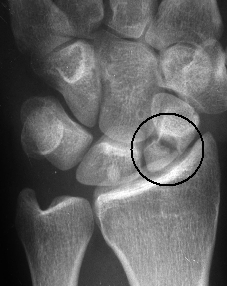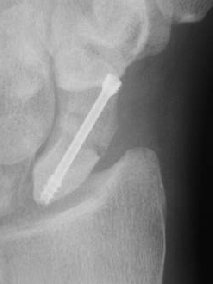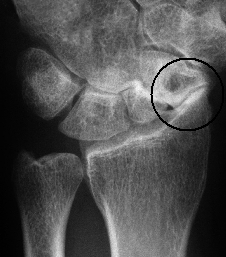What is scaphoid non-union?
Scaphoid non-union refers to a fracture of the scaphoid bone that has failed to heal (or unite - a non-union). The blood supply to the scaphoid is poor and the bone is mobile and difficult to immobilise in a cast. Whilst most scaphoid fractures heal without problems, some do not heal even with treatment.
Symptoms and signs:
These are variable:
-
no symptoms - some people do not have any symptoms and the non-union is found following x-rays taken after a minor injury.
-
wrist pain. This is typically experienced over the back of the wrist towards the thumb. It is worse with lifting or gripping and activities where the wrist is extended under load, such as during a press up or pushing yourself out of a chair from the sitting position.
-
wrist stiffness. loss of movement may be seen.
Diagnosis:
Non-union of the scaphoid bone should be considered as a possibility in patients with persistent wrist pain after a scaphoid fracture. Other patients at risk are those with persisting wrist pain after an apparently minor injury which was thought to be a wrist 'sprain'. In most cases the diagnosis is easily diagnosed after an x-ray. In some patients it may be necessary to investigate further with either CT or MRI scans. An MRI scan provides additional information on the remaining blood supply of the scaphoid bone, which may be helpful when considering surgical treatment.

Figure 1: non-union of a scaphoid fracture (circled)
Natural history of scaphoid non-union.
It is recognised that without treatment wrist arthritis will develop and this will be visible on x-rays. Surgical treatment may reduce this risk, but it does not completely remove it. There is however no correlation between the presence or severity of arthritis and the presence or severity of symptoms. Some people have wrist arthritis with minor or no symptoms. It is therefore not possible to predict who will develop wrist symptoms from a scaphoid non-union.
Treatment:
The decision on whether treatment is necessary and the most appropriate treatment for you should be made after discussion with your wrist surgeon.
Non-surgical
Some patients may elect not to have surgical treatment and chose a combination of painkillers, wrist splints and activity modification.
Surgical
The type of surgery depends partly on whether there is any wrist arthritis. In the absence of arthritis it is appropriate to try to get the fracture to heal. When arthritis is present the surgery is directed at treating this and not the scaphoid non-union.

Figure 2: non-union of a scaphoid fracture after bone graft and screw fixation
No Wrist arthritis:
Bone grafting and stabilisation with a screw. This involves insertion of bone graft into the fracture site. The bone graft may be taken from the iliac crest (pelvis) or distal radius bone. Bone graft taken from the radius bone can be left attached to blood vessels so that it remains alive (a vascularised bone graft). Surgeons differ in their treatment but my preferred treatment is to use a vascularised bone graft taken from the distal radius. This is performed as a half day-case procedure using regional anaesthesia (the arm is put to sleep). This has potential advantages in that the bone graft remains alive and it avoids the need for additional painful incisions to harvest the bone from the pelvis. You will remain in a wrist cast for between 6-8 weeks after surgery.
Wrist arthritis present:
Wrist denervation - this is a relatively minor surgical pain relieving operation where some deep nerves are removed. This reduces the wrist pain whilst maintaining the range of wrist movement.
Salvage procedures - there are a number of operations that either remove some wrist bones or partially/totally fuse some of the wrist joints. These options include a proximal row carpectomy, partial or total wrist arthrodesis (fusion). Such procedures are effective at removing pain, but they will remove between 50-100% of the total wrist movement.

Figure 3: non-union of a scaphoid fracture with wrist arthritis (circled)
Results of Surgery:
The success of bone graft surgery depends on many factors including the site of the non-union, whether the bone fragments have a blood supply and the time that has elapsed since the injury. Overall successful union is achieved in between 50 - 90% of cases. You will be able to discuss this with your surgeon.